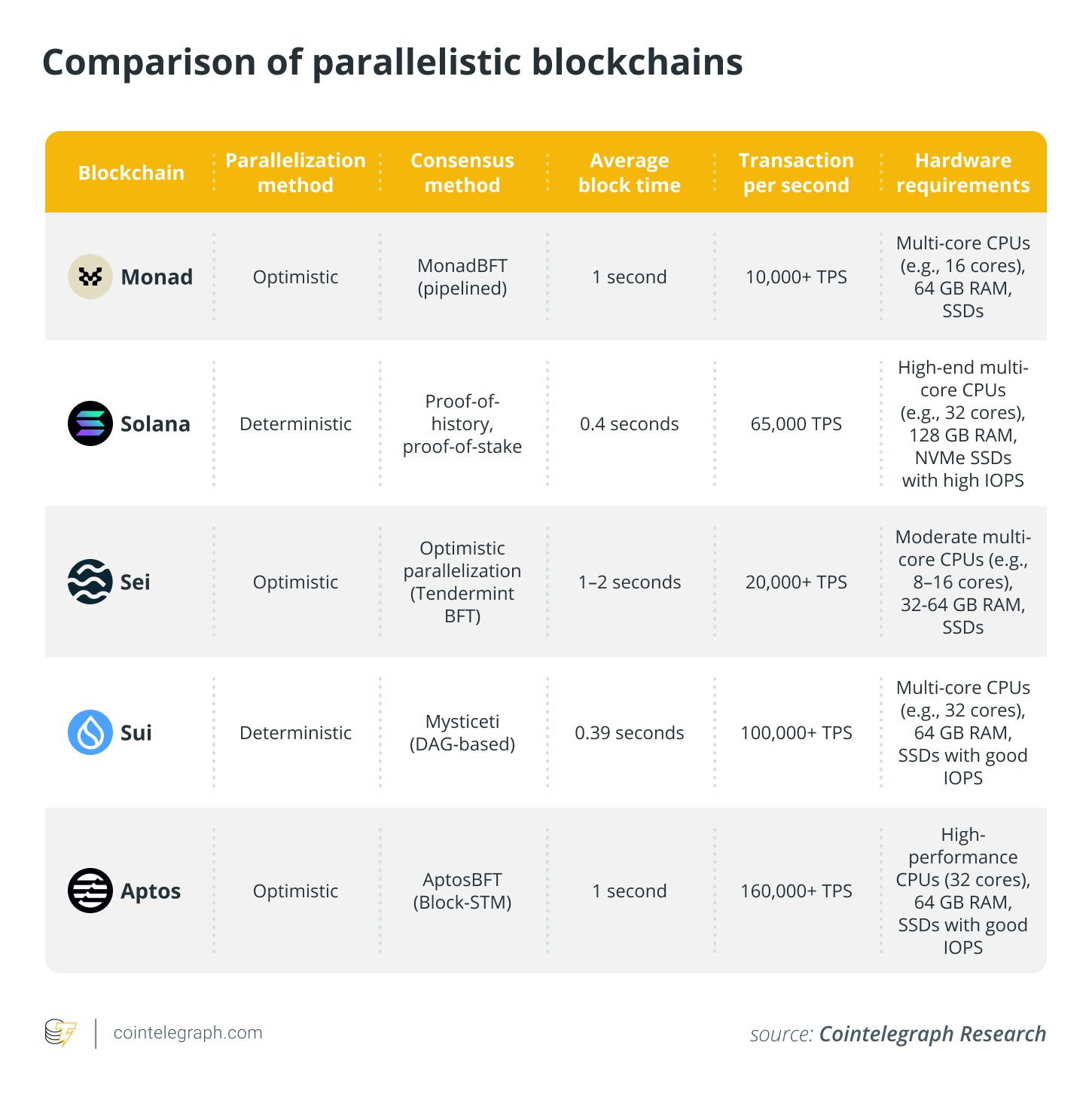Monad is a promising Layer-1 smart contract platform that recently secured $225 million in funding, led by Paradigm. Aiming to address blockchain scalability challenges, Monad employs parallel Ethereum Virtual Machine (EVM) execution. This means it can process multiple transactions simultaneously, significantly increasing throughput and reducing costs. Expected to launch its public testnet in late 2024, with mainnet deployment planned for early 2025, Monad introduces several key innovations.
Here’s a breakdown of Monad’s core features and how they contribute to its enhanced performance:

Key Innovations of Monad Blockchain
- MonadBFT: A pipelined two-phase Byzantine Fault Tolerance (BFT) algorithm enhancing blockchain scalability and efficiency.
- Deferred Execution: Decouples transaction execution from consensus, focusing consensus solely on transaction order.
- Parallel Execution: Uses optimistic execution for parallel transaction processing, boosting overall throughput.
- MonadDB: A custom database optimizing parallel execution through asynchronous disk operations.
MonadBFT: Enhanced Consensus Mechanism
MonadBFT is designed to improve upon traditional BFT algorithms like HotStuff, which requires three communication rounds to reach a consensus. MonadBFT reduces this to two rounds, optimizing the consensus process. It operates effectively under partially synchronous conditions, which are common in real-world networks. The algorithm involves:
- Leader Proposal: A leader node proposes blocks for validation.
- Validator Review: Validators review the proposed blocks.
- Quorum Certificates (QC): Proof that a majority of validators have approved a block.
- Timeout Certificates (TC): A fallback mechanism when consensus isn’t reached within a timeframe.
This two-phase commit rule ensures rapid block finalization while maintaining network security and fault tolerance. Crucially, for security, two-thirds of Monad’s validator nodes must be non-adversarial.

Deferred Execution: Separating Execution from Consensus
Traditional blockchains, such as Ethereum, require nodes to execute transactions before establishing consensus. This can create bottlenecks. Monad’s deferred execution separates transaction execution from the consensus process. MonadBFT focuses on agreeing on the order of transactions, allowing execution to occur independently afterward.
To ensure correct execution, Monad delays agreement on the Merkle root of the state by a certain number of blocks (D, currently expected to be 10). This mitigates risks associated with malicious nodes. If a node detects an error, it votes against the proposal, triggering a rollback and re-execution of transactions.
Parallel Execution: Optimistic Concurrency
Monad uses optimistic execution to achieve parallel transaction processing. This is akin to speculative execution in CPUs, where processes begin before prior ones finalize, boosting throughput. If conflicts are detected (e.g., two transactions modify the same account), the affected transactions are re-executed.
Monad employs a static code analyzer to predict dependencies between transactions, further optimizing transaction scheduling. This reduces the likelihood of conflicts. While similar to Sei, Monad’s static-code analyzer gives it an edge in efficient transaction scheduling.

Compared to deterministic methods used by Sui and Solana, optimistic execution eliminates the need for complex scheduling algorithms. Deterministic systems require upfront declaration of state access, leading to overhead. Monad’s approach balances efficiency and complexity.
MonadDB: Optimizing I/O Access
MonadDB is a custom database designed to optimize parallel execution. Traditional blockchains suffer from I/O bottlenecks due to synchronous operations. MonadDB uses asynchronous disk operations, initiating multiple read/write operations simultaneously. This significantly enhances the speed of transaction processing.

Monad’s Potential Impact
Monad offers a compelling suite of technological advancements. By combining MonadBFT, deferred execution, optimistic parallelization, and MonadDB, the platform could significantly increase transaction processing capabilities while maintaining robust security. The ability to process transactions in parallel, predict potential conflicts, and optimize I/O access could greatly reduce bottlenecks seen in other blockchain networks. Monad’s approach to scalability and efficiency could make it a notable contender in the blockchain space.
Conclusion: A Scalable Blockchain Platform
Monad presents a significant step forward in blockchain technology by leveraging optimistic execution, deferred execution, and MonadDB. Its optimistic parallelization, similar to CPUs’ speculative execution, facilitates high throughput by processing transactions concurrently. The incorporation of static code analysis and MonadBFT ensures rapid block finalization and network security.
As Monad approaches its public testnet and mainnet deployment, it stands as a strong contender in the evolution of scalable blockchain platforms. The platform is poised to significantly impact the industry with its unique blend of innovation and efficiency.